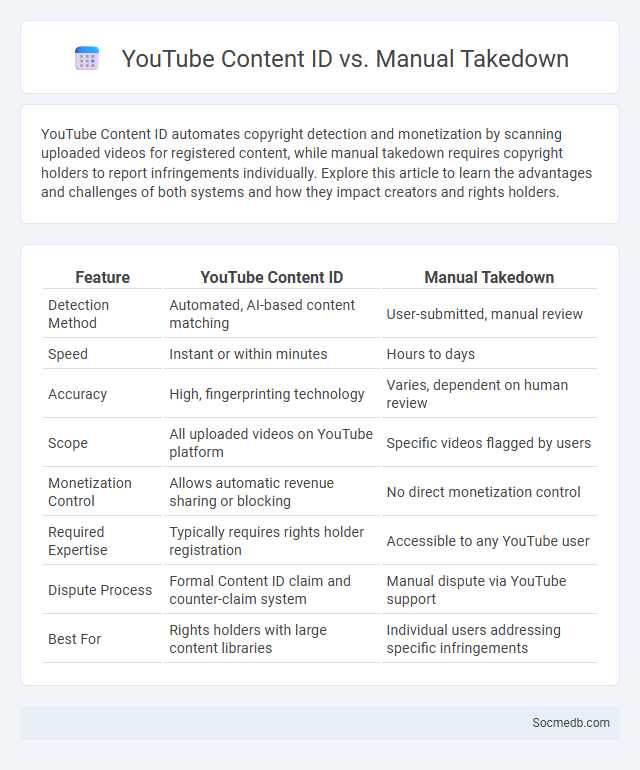
Photo illustration: YouTube Content ID vs Manual Takedown
YouTube Content ID automates copyright detection and monetization by scanning uploaded videos for registered content, while manual takedown requires copyright holders to report infringements individually. Explore this article to learn the advantages and challenges of both systems and how they impact creators and rights holders.
Table of Comparison
| Feature | YouTube Content ID | Manual Takedown |
|---|---|---|
| Detection Method | Automated, AI-based content matching | User-submitted, manual review |
| Speed | Instant or within minutes | Hours to days |
| Accuracy | High, fingerprinting technology | Varies, dependent on human review |
| Scope | All uploaded videos on YouTube platform | Specific videos flagged by users |
| Monetization Control | Allows automatic revenue sharing or blocking | No direct monetization control |
| Required Expertise | Typically requires rights holder registration | Accessible to any YouTube user |
| Dispute Process | Formal Content ID claim and counter-claim system | Manual dispute via YouTube support |
| Best For | Rights holders with large content libraries | Individual users addressing specific infringements |
Understanding YouTube’s Copyright System
YouTube's copyright system uses Content ID to automatically detect copyrighted material in your videos, helping rights holders protect their content. When copyrighted content is detected, YouTube may block your video, monetize it on behalf of the owner, or issue a strike against your channel. Understanding these policies ensures you manage your content responsibly and avoid penalties.
What is YouTube Content ID?
YouTube Content ID is a powerful digital fingerprinting system that automatically scans uploaded videos against a database of copyrighted material to identify any matches. When content you own is detected, the tool enables you to manage your rights by monetizing, tracking, or blocking the videos containing your copyrighted work. This system helps protect your intellectual property while allowing YouTube creators to share content legally.
How Content ID Matches Work
Content ID matches work by scanning uploaded videos for copyrighted material using a vast database of reference files provided by copyright owners. The system identifies audio and visual elements, generating a unique digital fingerprint to compare against new content. When a match occurs, rights holders can choose to block, monetize, or track the video based on their content policies.
Manual Takedowns Explained
Manual takedowns on social media involve human reviewers who assess flagged content against platform policies, ensuring accuracy beyond automated detection tools. This process helps remove harmful or inappropriate posts, maintaining a safer community environment. Your reports contribute to manual takedown decisions, empowering platforms to act swiftly and responsibly.
Key Differences: Content ID vs. Manual Takedown
Content ID automates copyright detection by scanning uploaded media against a database of copyrighted material, enabling rights holders to claim, monetize, or block infringing content swiftly. Manual takedown requires rights holders to identify violations themselves and submit formal requests for content removal, often leading to slower enforcement and greater labor involvement. Content ID offers scalability and immediate response, while manual takedown relies on human intervention and detailed evidence submission, impacting efficiency in content regulation on social media platforms.
Pros and Cons of Content ID
Content ID simplifies copyright management by allowing creators and rights holders to automatically detect unauthorized use of their work on platforms like YouTube. You can monetize, track, or block videos containing your protected content, ensuring control and revenue generation. However, the system sometimes misidentifies fair use or non-infringing content, leading to disputes and potential unfair penalties.
Pros and Cons of Manual Takedown
Manual takedown of social media content allows precise control over the removal of harmful or infringing posts, ensuring accuracy and reducing unintended censorship. However, this process can be time-consuming, delaying response to urgent issues and allowing damaging content to remain visible longer. Your ability to swiftly navigate the manual takedown steps directly influences the effectiveness and timeliness of content moderation on your platforms.
Impact on Creators and Channel Owners
Social media platforms have revolutionized content creation, enabling creators and channel owners to reach global audiences directly while monetizing their work through ads, sponsorships, and subscriptions. These platforms provide data analytics tools that help creators optimize content strategy, increase engagement, and grow follower bases efficiently. However, the reliance on algorithm-driven visibility can cause volatility in reach and revenue, demanding continuous adaptation from creators to sustain their online presence.
How to Respond to Content ID and Takedown Claims
When you receive a Content ID or takedown claim on social media, review the specific infringement notice thoroughly to understand the reason behind it. Gather evidence of your rights or fair use, such as licenses or permissions, and submit a well-documented counter-notification according to the platform's policies. Protect your content and maintain your channel's standing by addressing disputes promptly and transparently, ensuring your voice remains heard.
Best Practices for Avoiding Copyright Issues on YouTube
To avoid copyright issues on YouTube, always use original content or obtain proper licenses for music, videos, and images included in your uploads. You should utilize YouTube's Content ID system and fair use guidelines to manage copyrighted materials effectively. Ensuring your content complies with YouTube's copyright policies protects your channel from strikes and potential takedowns.
 socmedb.com
socmedb.com